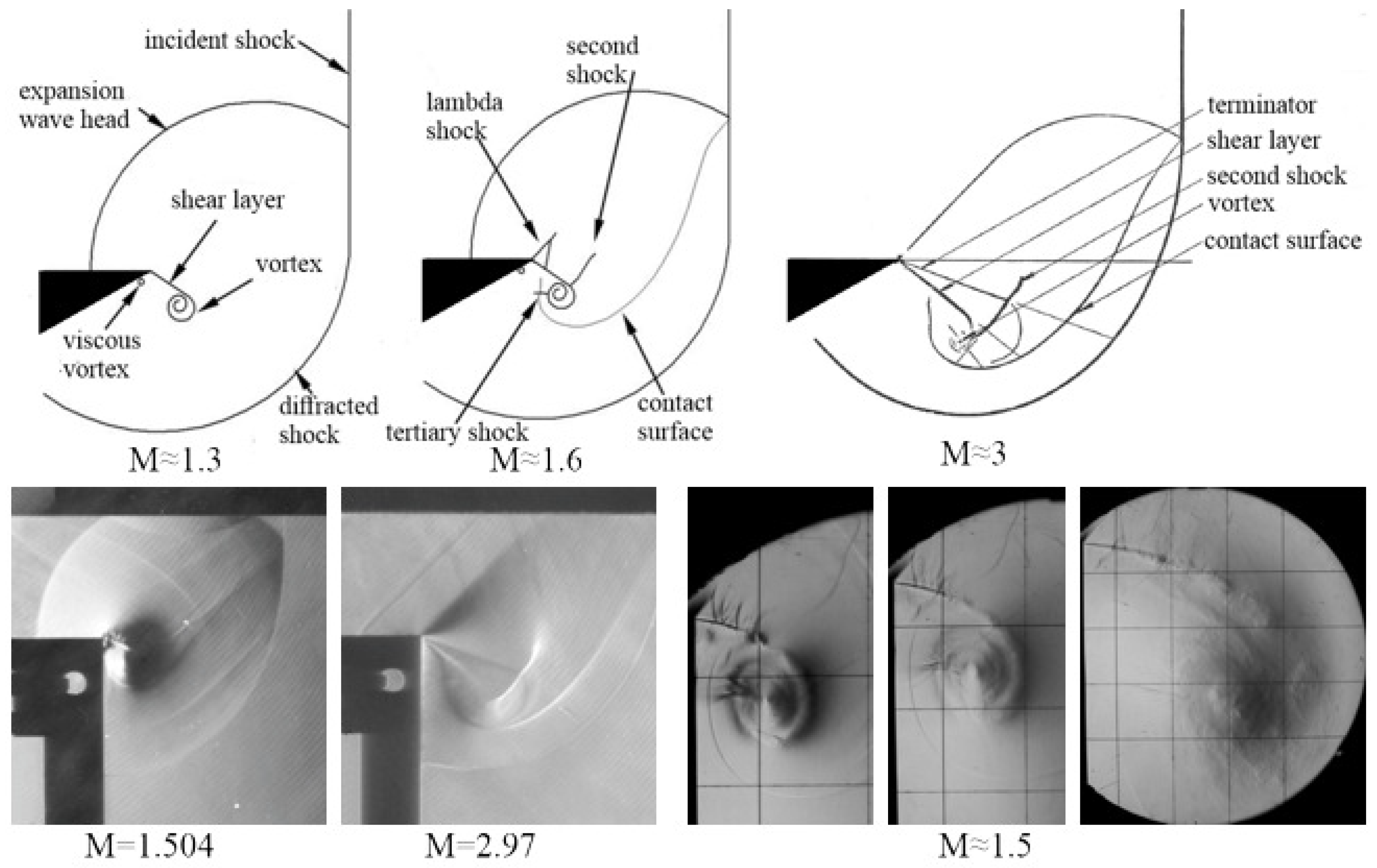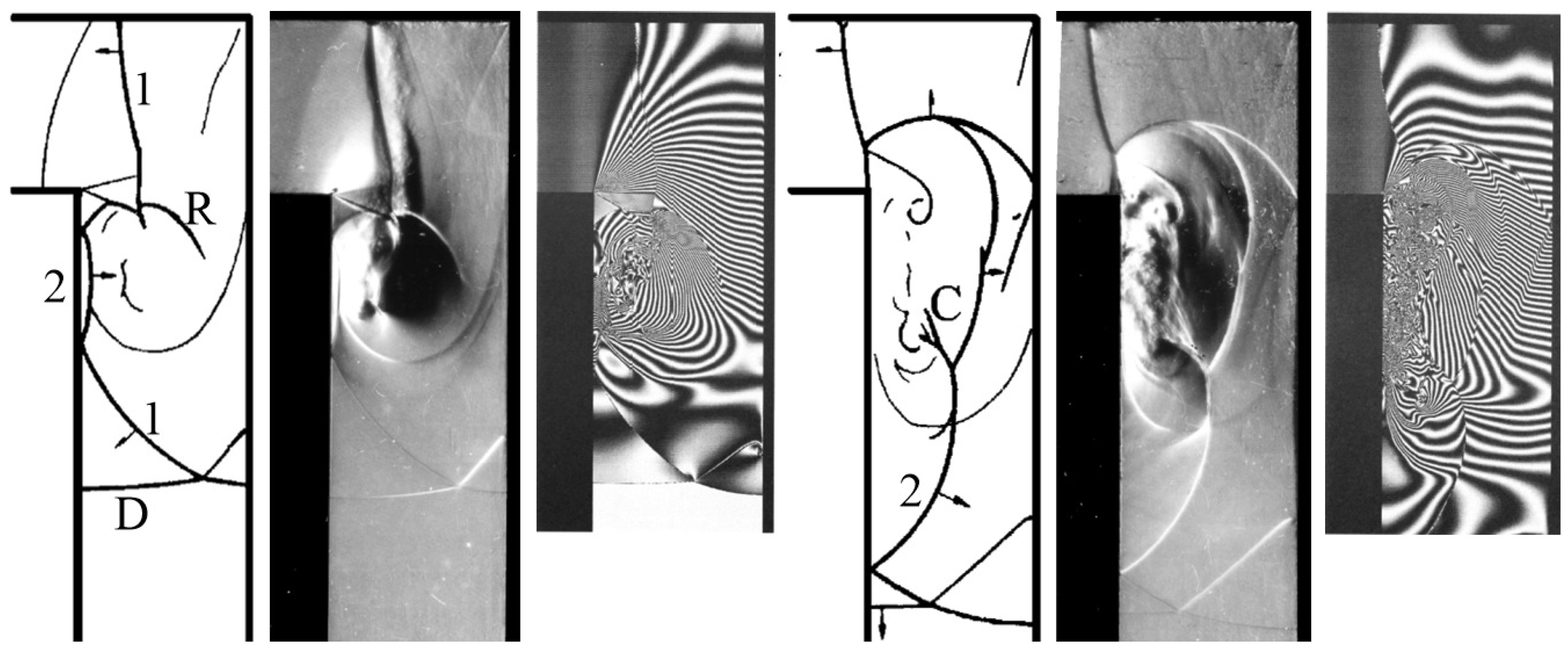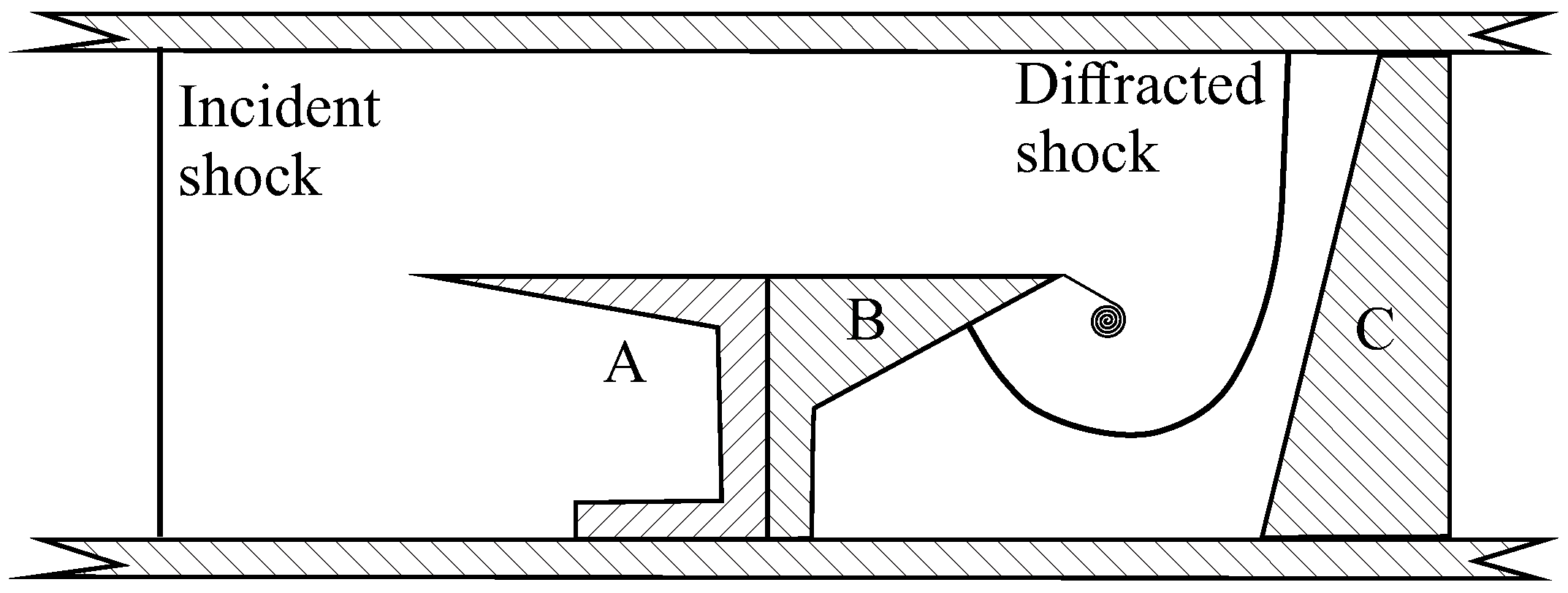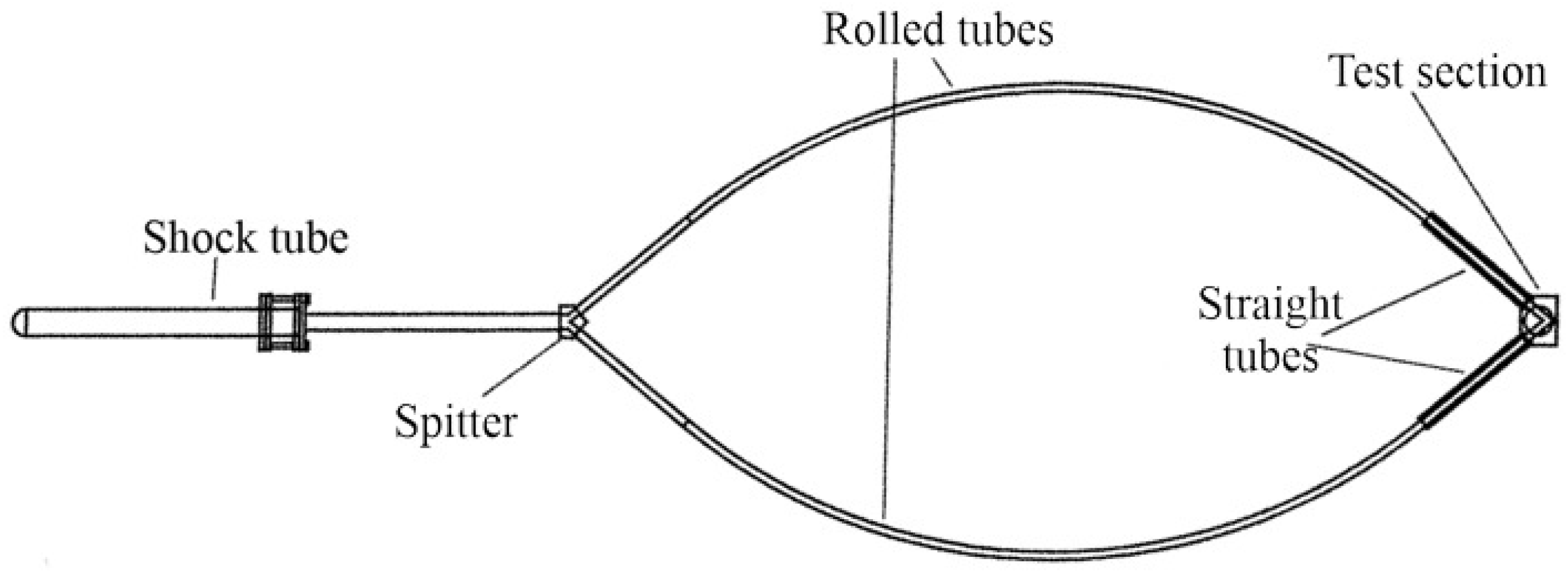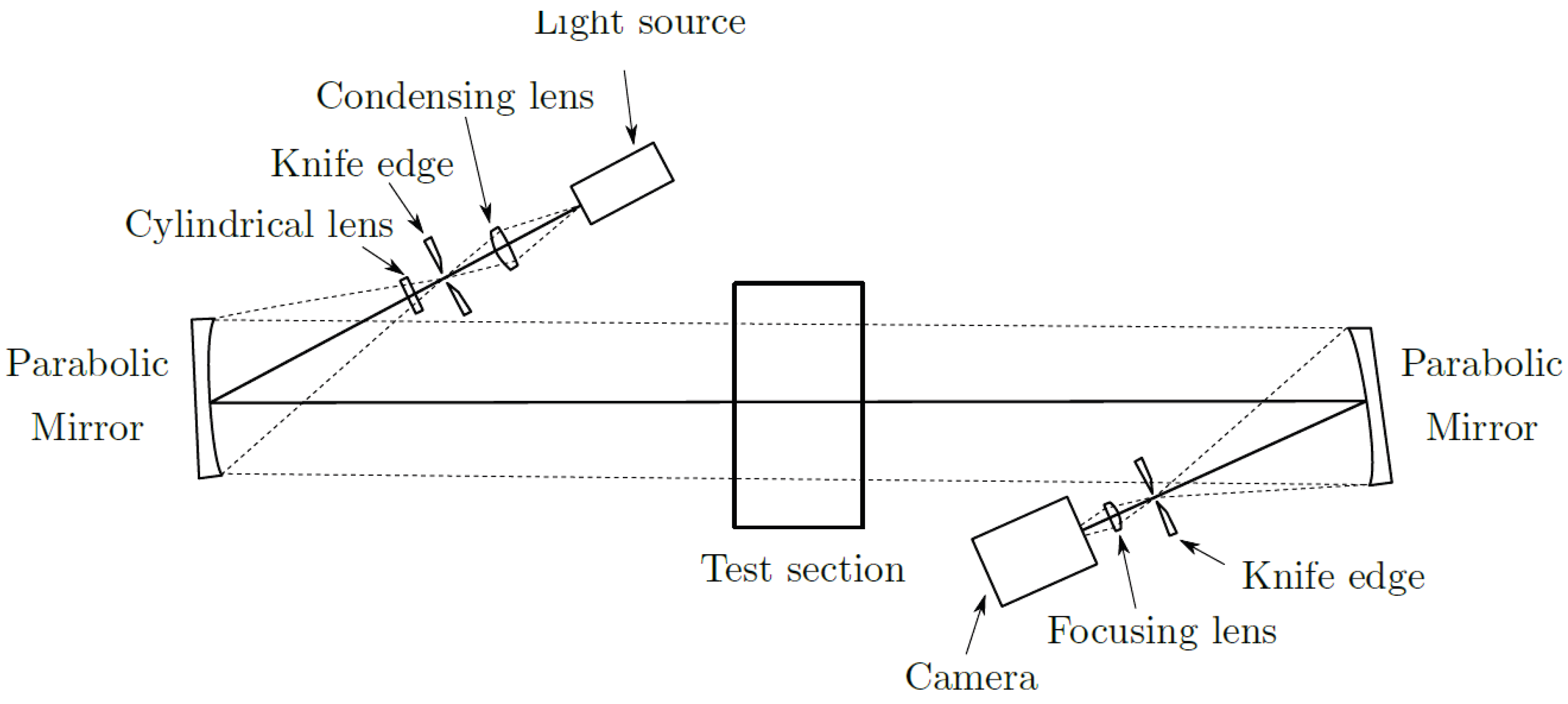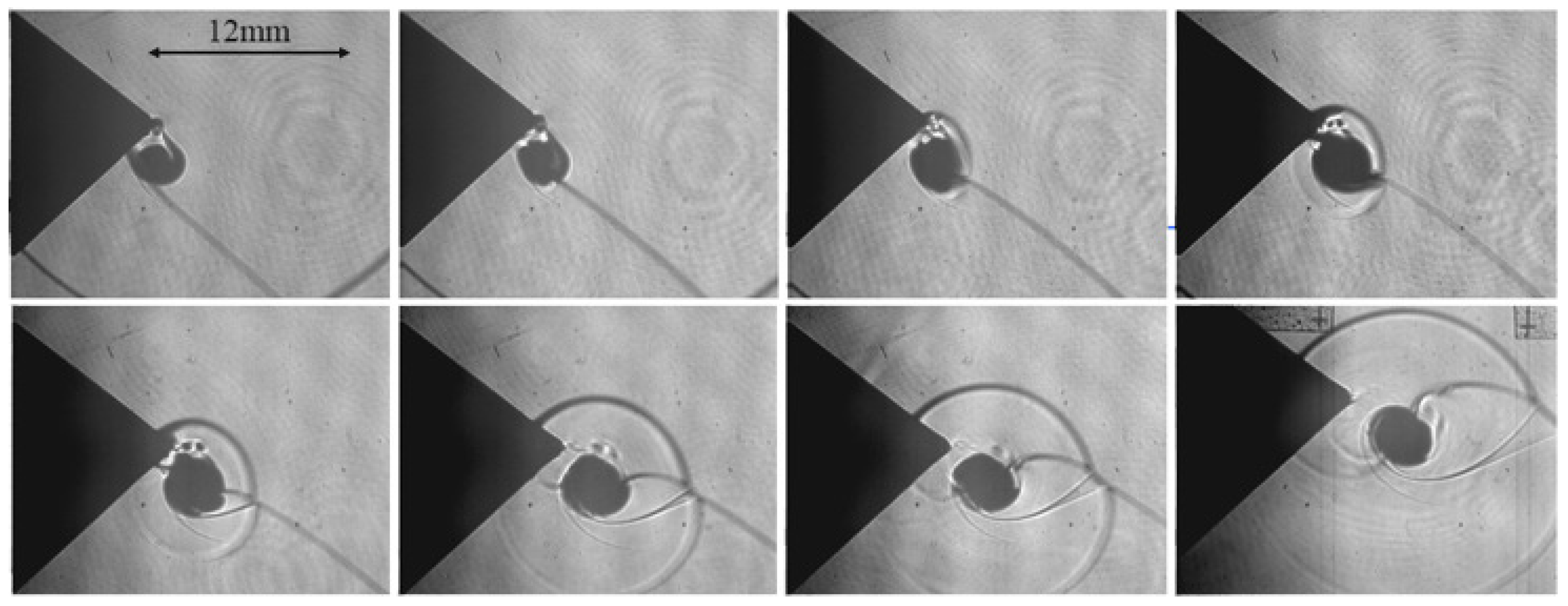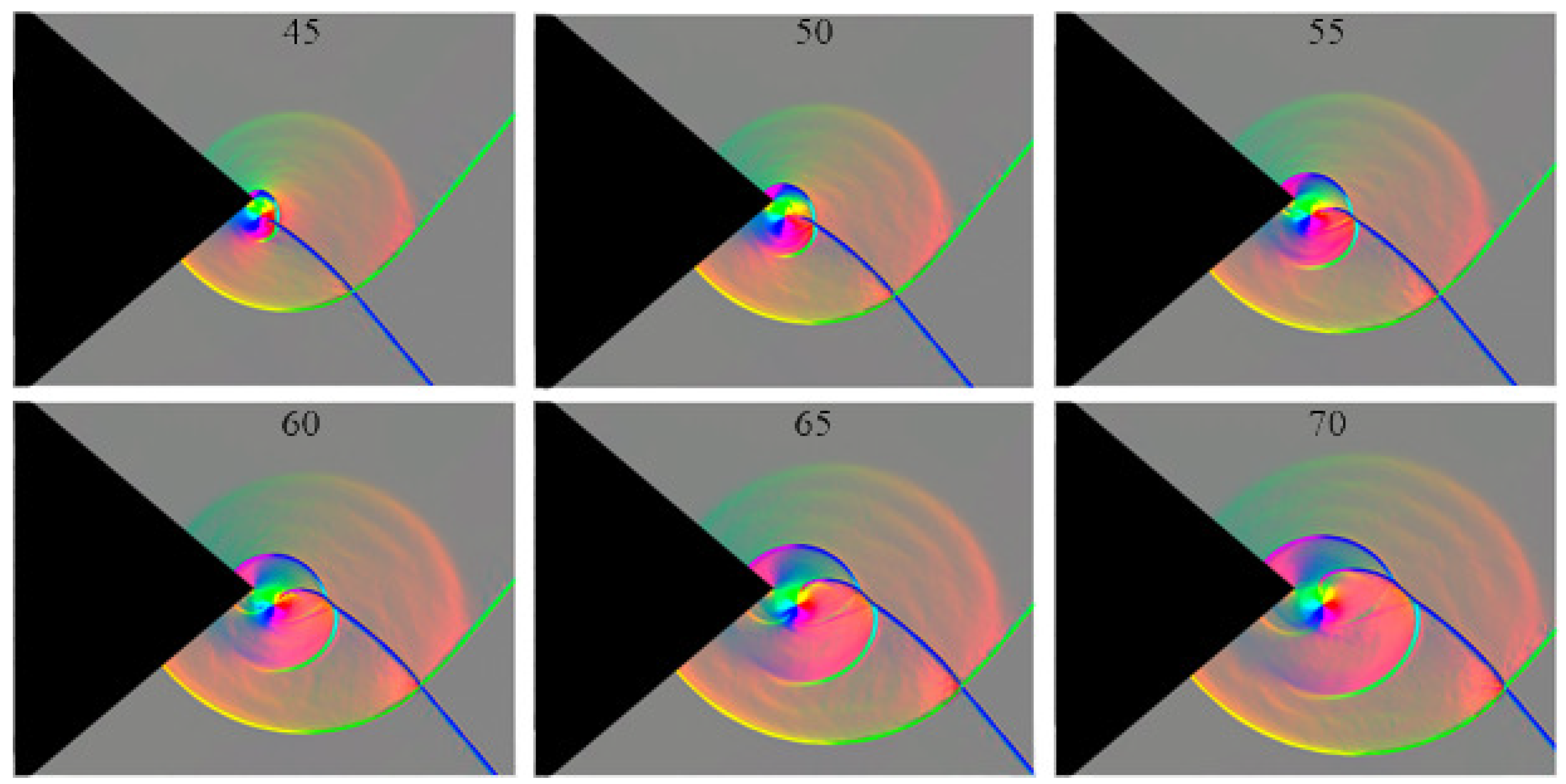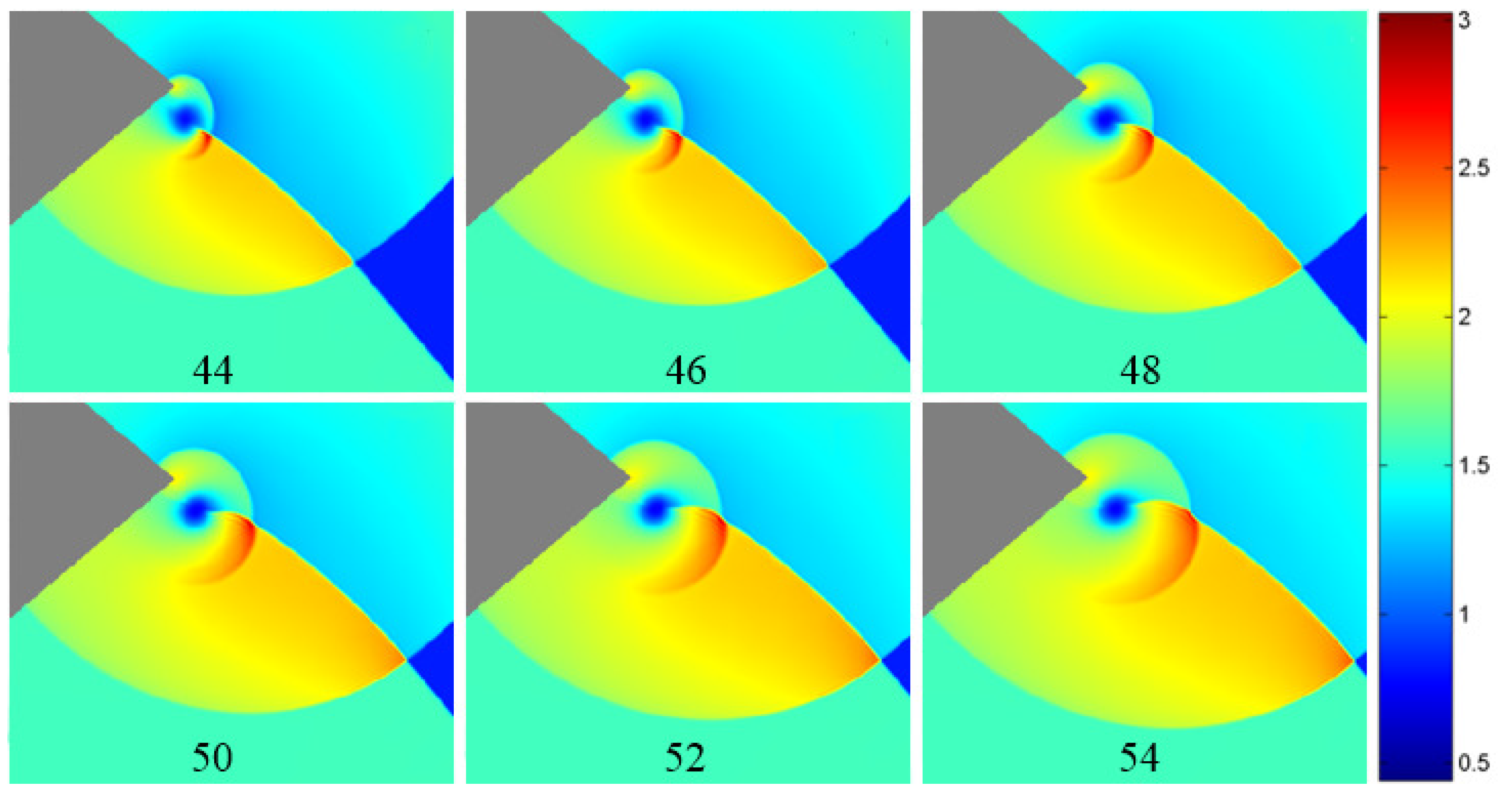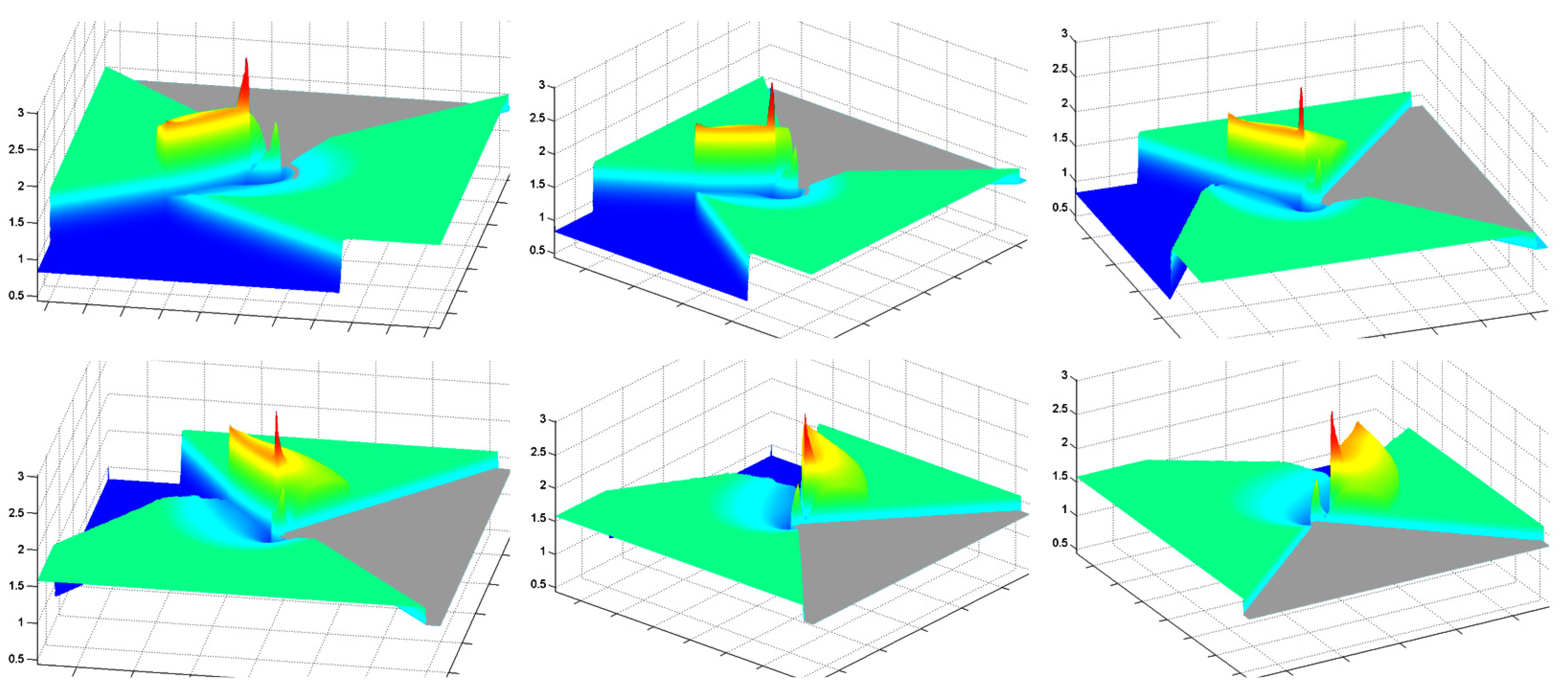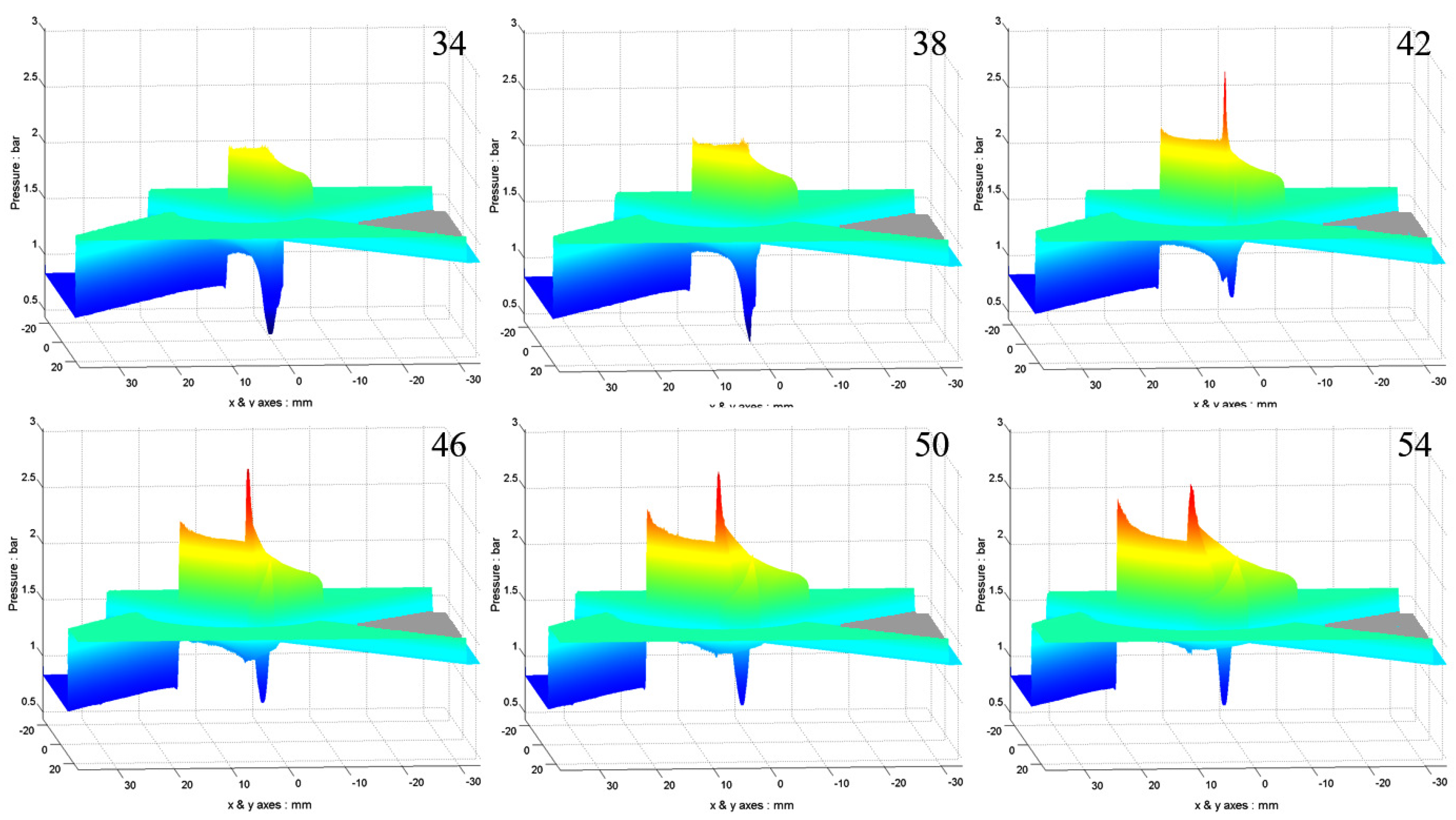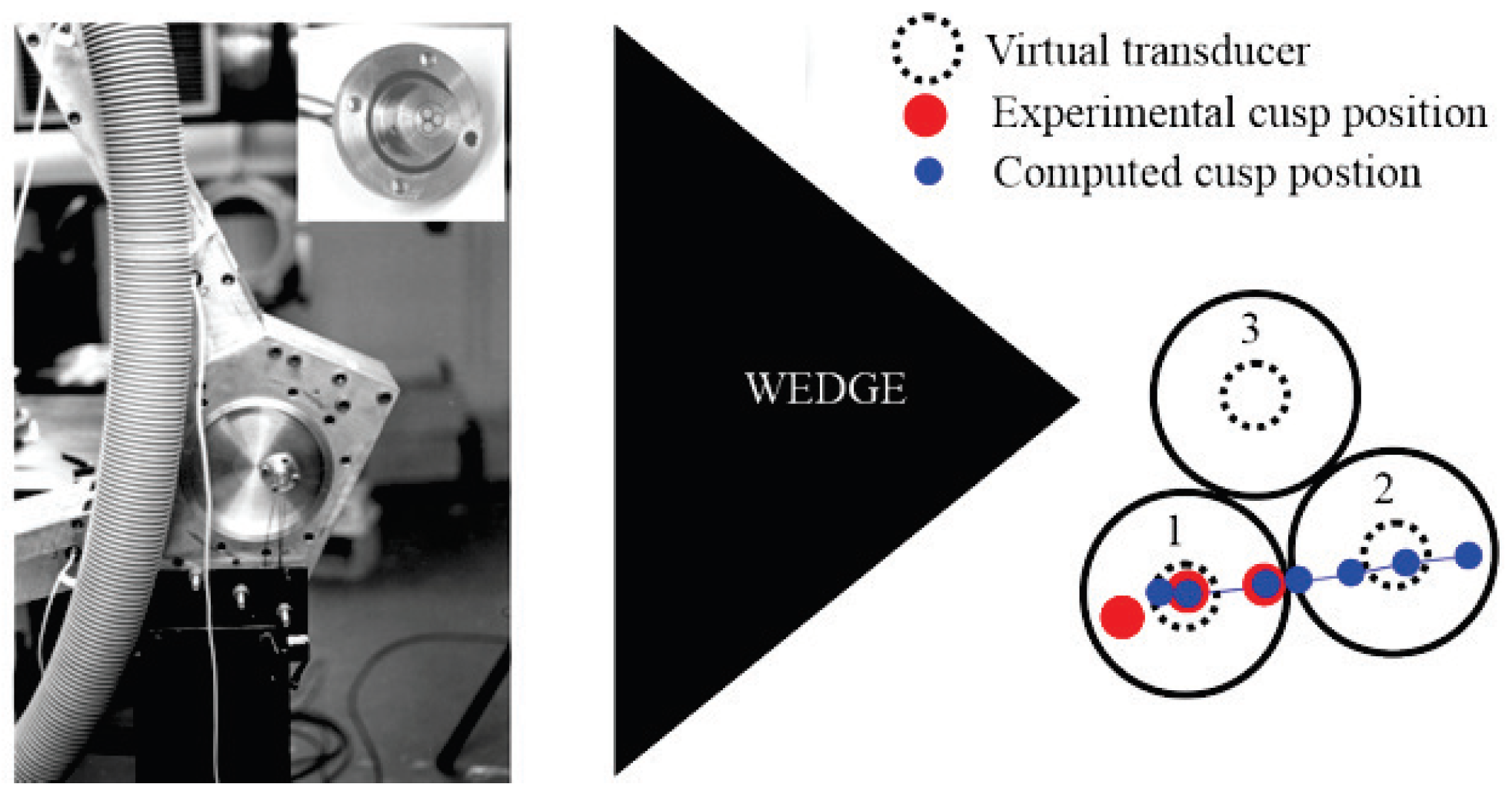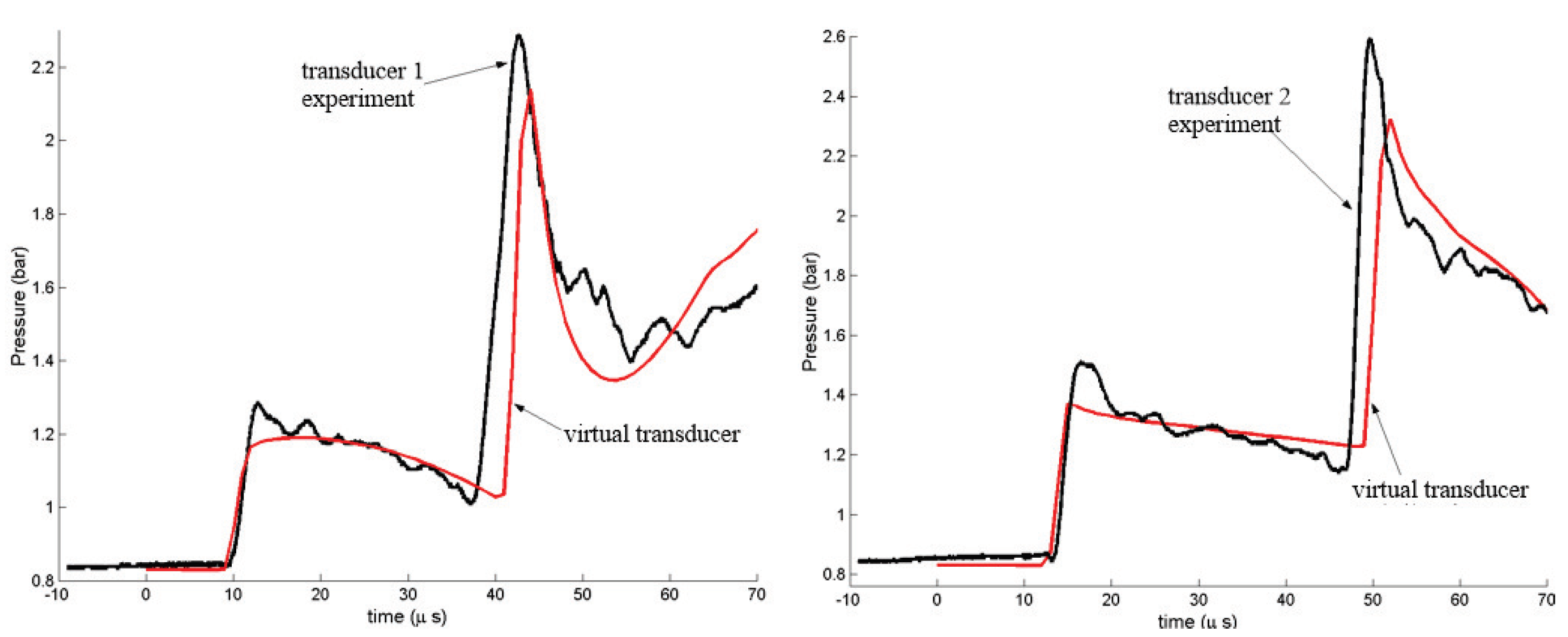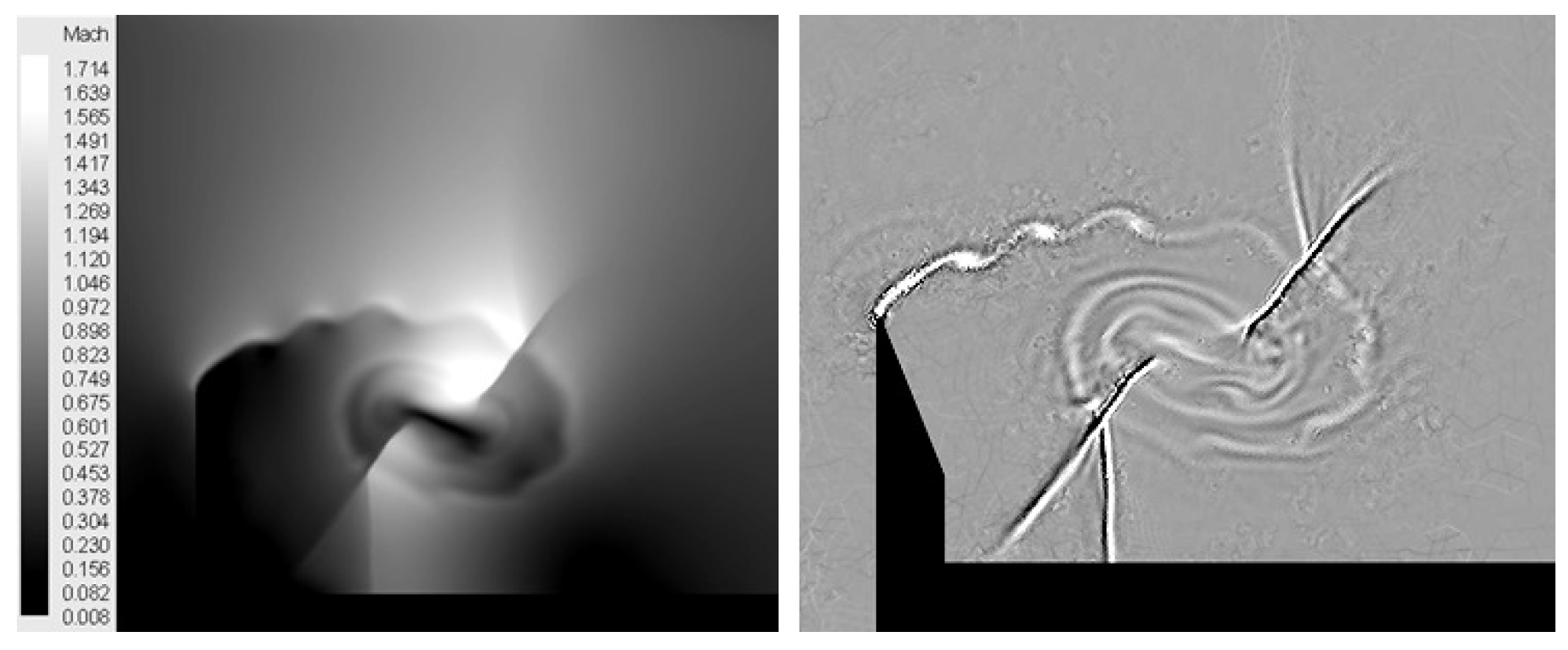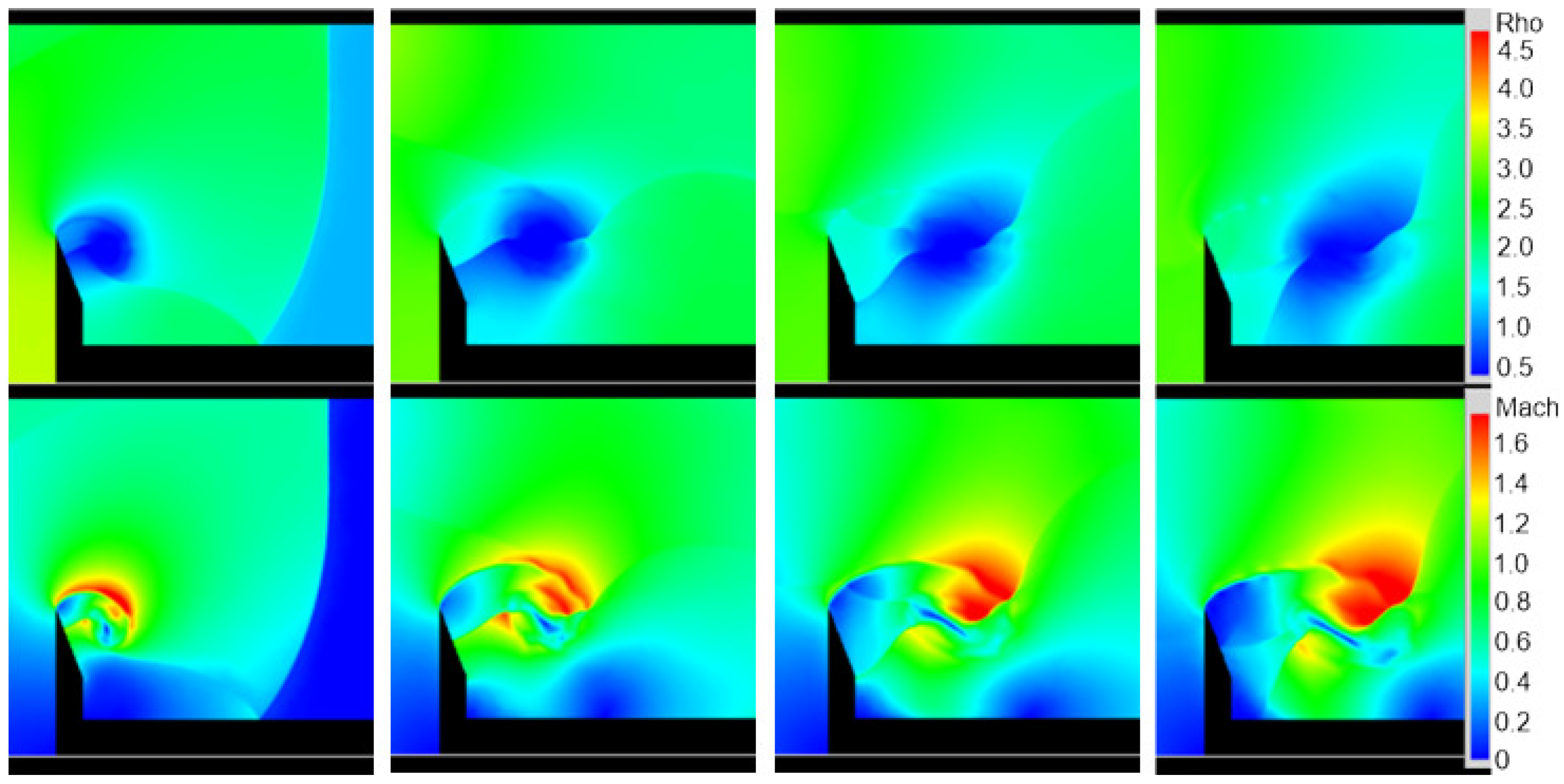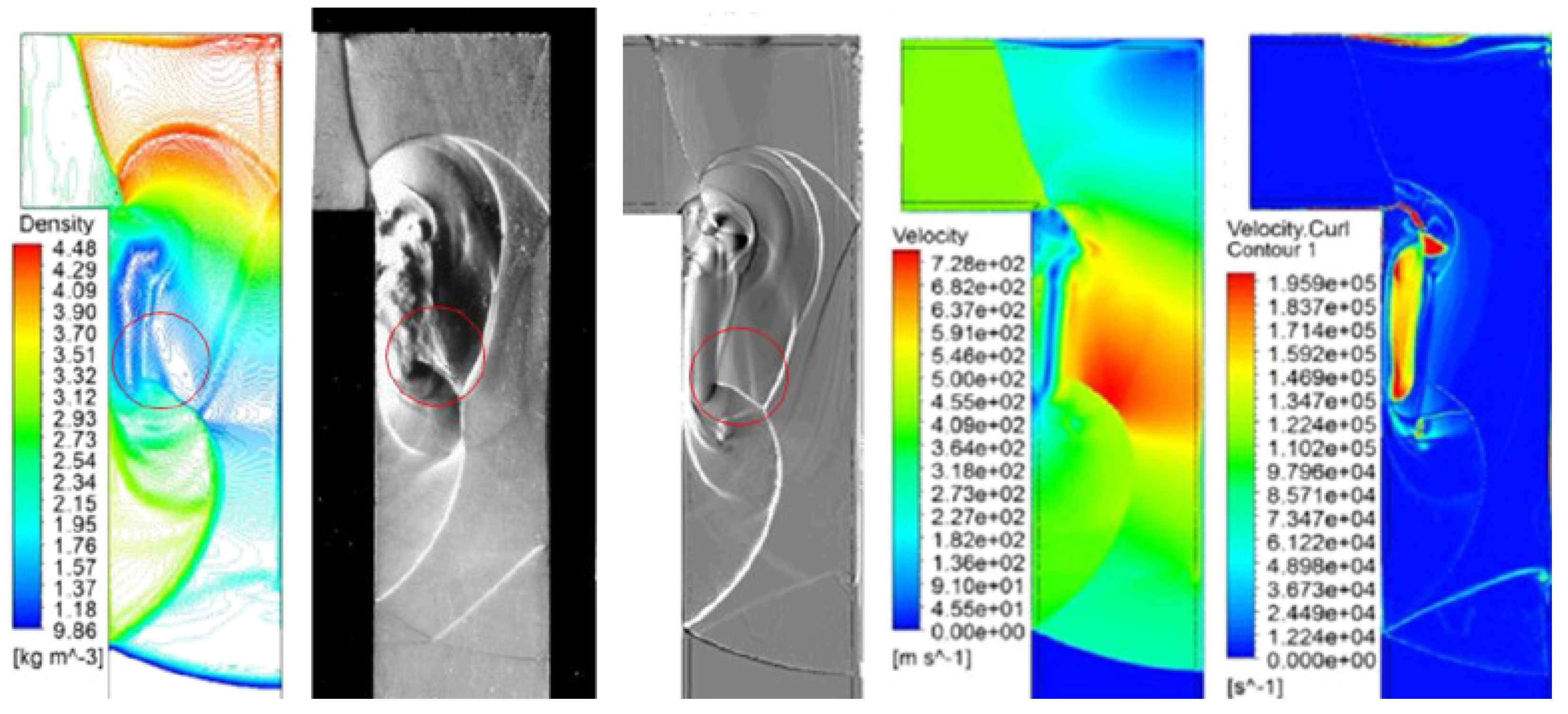3.1. Single Shock Passage
Preliminary experimental results using the facility of
Figure 5 were reported in [
16]. A number of magnified images using a laser light source are given in
Figure 7. The test piece at the exit of the two legs of the rig is a
wedge. The shock wave from the top leg of the rig arrives early entering from the upper right, shedding a vortex, and that from the lower leg, bottom right, transverse over the vortex. The difference between the arrival times at the corner,
, are given in the figure. The left and right images, with similar delay times, are taken at different times thereby showing the evolution of the interaction in time. The first image shows the development of the double Mach reflection with the shear layers propagating to the vortex with the two triple points corresponding to the pattern in
Figure 1c. The centre image is at an earlier stage of development because of the much larger delay time between the two waves arriving at the corner. The fast diffracted shock, FDS, and and associated reflected shock, RS2, appear to be doubled into separate waves. Similar effects are evident for the reflected shock in previous work [
4,
5] although the geometry of the experiment is somewhat different. There is no clear Mach stem and the reflection appears to be regular but with a clear shear layer. Whether this is due to different shock strengths on either side which would produce a shear layer, or a small Mach stem which is not resolved is not clear. There is an additional feature of a shock between the vortex and the wall which does not appear in the two cases with a lower synchronization delay. There are also two vortices shed from the corner. The details of this flow is that the vortex induced flow is up the surface towards the corner and separates there with the shock acting to decelerate the flow to meet the shear layer.
Additional work was presented in [
17].
Figure 8 shows more images from a series of tests at the same nominal Mach number and same delay time between arrival of the two shock waves at the corner. The vortex appears as dark blob because of the high density gradients and corresponding refractive index gradients resulting in total internal reflection of the laser beam. There is some correspondence with previous numerical predictions for the isolated vortex case but noticeable differences due to the presence of the shear layer and with the vortex being close to the wall. Both the last frame in the top row and first frame in the bottom row show small vortices being shed off the corner and a shock between the vortex and the wall as also noted in
Figure 7. These slowly dissipate as the vortex moves away from the wall. The shock moves away from the corner in the opposite direction to the clockwise upward flow of the vortex. The last frame shows a complex interaction as the reflected wave from the upper triple point enters the influence of the vortex where it becomes distorted.
Detailed numerical simulations of this case were undertaken.
Figure 9 shows a series of colour schlieren images for a single Mach number and constant difference in time interval between arrival time of the two shocks. This technique clearly defines the vortex centre where the six colours: red, magenta, blue, cyan, green, and yellow meet at a point. At
s the diffraction pattern of the first wave and associated vortex are well developed. This is the fast diffracted shock, FDS, defined earlier. The later arriving second wave is about halfway into the vortex. There is no slow diffracted shock near the wall but rather a jet like flow as described when dealing with
Figure 8. As the wave propagates through the diffracted part emerges and meets the blue incident wave in a regular reflection, as shown at
s, with the development of associated reflected waves. The highly curved diffracted wave expands and moves up the upper surface of the wedge. The angle between the incident and diffracted wave becomes larger resulting in the reflection becoming a Mach reflection. The slipstreams that develop from the triple points are wound up into the vortex, with the end of the reflected wave from the upper triple point also merging with the vortex. More detail, at much larger scale, is given in the numerical shadowgraph of
Figure 10. The physical area covered in these images is about 7 mm
with the vortex being about 0.4 mm in diameter. As the wave enters the vortex field it is distorted more and more, part becoming almost parallel to the shear layer which results from the the earlier shock diffraction. It then develops a cusp with the forming of a regular reflection after having passed through the shear layer. These images also identify the development of the shock between the vortex and the wall, which propagates away from the corner. It is associated with the diffracted wave reflecting off the corner. This interaction, with the jetting effect up the surface, also results in significant distortion of the shear layer.
Previous work dealing with shock interaction with an ideal isolated vortex paid particular attention to the pressure field.
Figure 11 shows numerical results for the present case with the spiral vortex from shock diffraction, corresponding to the test case above. The slightly variable yellow region correspond to the gas which has experienced passage by both shocks being modified slightly by the changing strength of the diffraction of the early arriving wave, which also results in a slight curvature of the late arriving wave. This plateau of pressure changes significantly in the region of the vortex, shown in blue. A high pressure region shown in red, grows in space and time behind the reflected wave which results from the appearance of the regular and Mach reflections at the cusp between the incident and diffracted waves. This pressure spike is very close in position to that of the vortex, resulting in extremely high pressure gradients. As the flow progresses the pressure at the intersection between the two incident waves moving into undisturbed gas starts to rise as noted in the figure and can exceed that of the pressure spike developed at the cusp but is not part of the shock-vortex interaction itself. There is also a pressure increase at the wedge corner when the diffracted shock reflects off it.
Animations of the pressure distributions have been done with
Figure 12 showing the pressure surface at
s viewed from different angles and
Figure 13 showing evolution in time. The gray wedge surface is set at an arbitrary pressure level. The green area is the uniform pressure behind the plane shock waves. Both pressure spikes are evident.
Whilst the numerical results provide a comprehensive description of the flow experiments are needed in order to assess their validity. All the main features found in the experiment, shown in
Figure 8, correspond to those in the simulation shown in
Figure 9. The pressure spike is extremely narrow, about 0.5 mm in diameter at mid-height and of short duration, thus making it difficult to measure experimentally. The track of the position of the peak pressure is obtained from the numerical data and small transducers are positioned in the region of the track. Three transducers each having an outside diameter of 3.8 mm and a sensor element radius of 0.4 mm are arranged in rosette pattern as shown in the inset of
Figure 14, and situated in a plate replacing a window in the rig. The position relative to that of both the numerical and experimental spike positions is indicated in the figure. The virtual transducer is the size of the sensing element. Transducer 1 was placed where the pressure spike is a maximum and transducer 2 in the region of the spike trajectory.
The CFD essentially gives a point measurement of the peak pressure but the transducer is exposed to pressure across its sensing face. To account for this further simulations were done by averaging the pressure over the sensor face area to represent what would be measured by a virtual transducer of 0.4 mm radius. The effect of this averaging comparing the point pressure to the averaged value for comparison to experiment is given in
Figure 15. The point pressure traces from the numerical simulation at the positions of the three transducers is given together with the effect of simulations for a transducer of 0.4 mm radius. The point measurement for transducer 2 shows that the pressure spike is about 230% above that behind the diffracted shock wave, at 2.75 bar. Transducer 2 still records the spike but is lower because it is not directly on the track of the spike.
It is evident that although the virtual transducer, having a finite size, reduces the peak pressure it is sufficient to measure and identify the spike reasonably well.
Figure 16 compares the virtual transducer output with that obtained experimentally. There is considerable agreement considering the complexity of the experiment. The spike width and arrival time are well predicted, the former within 5% and the latter within
s.
Limited items from the above study using the bifurcated tube at Mach 1.33 and
s have been published in [
18]. Preliminary work at higher Mach numbers, particularly when the flow behind the incident waves is supersonic, which occurs with a Mach number graeater than 2.07, raises practical issues since the tube needs to be evacuated. A few results in this region have been done [
19]. Results for a variety of Mach numbers are given in
Figure 17. The much lower test section density results in some loss of definition in the vortex. In the first image in which the flow behind the shocks is subsonic the overall pattern is similar to the Mach 1.33 case discussed above. However, as the Mach number increases the overall pattern becomes extended in the flow direction. The shear layers from the two triple points merge as they get caught up in the vortex flow. For the higher Mach number cases where the post-shock flow is supersonic the diffraction pattern on a corner is different as given in
Figure 2.
At Mach 2.24 only one triple point is clearly evident although there is a second slipstream emanating from the region where the incident shocks intersect. No second reflected shock is evident. The reflected shock propagating on the upper surface is inclined as an oblique shock in a supersonic stream. At the slightly higher Mach number, which was taken at a lower difference between arrival times at the corner, the reflected wave becomes distorted as it meets the oncoming supersonic flow. At Mach 2.5 the incident shock intersection is a strong Mach reflection with shear layers that terminate into a pair of adjacent vortices which curl up rather than moving downstream. This is characteristic of strong Mach reflection from a surface. Since they are not of equal strength a trailing slipstream emanates from where they meet and is caught up in the vortex. In all the supersonic cases the vortex pattern itself is not well defined. This is a case which has not been explored previously and additional tests are required together with numerical simulation in order to establish the details.
3.2. Multiple Shock Passage
The reason for examining the interaction where a vortex is traversed by a shock wave more than once is that it shows possible vortex disruption and occurs in a number of practical cases.
A very interesting experimental case of a complex shock-vortex interaction with multiple transits and a spiral vortex is partly contained in a video `Waves in Fluids’ [
20]. It deals with shock wave propagation over a fence. This case did not deal with the shock/vortex interactions at all but was an illustration of complex flows resulting from shock interaction with a simple boundary. A number of frames have been extracted from the video and annotated in
Figure 18. The incident wave diffracts over the fence with the curved portion reflecting off the bottom surface and passing through the vortex in the typical S-shaped format, giving rise to the diffracted wave D, emerging from the opposite side just below the shear layer.There are embedded shocks in the vortex on either side of the vortex core. These indicate acceleration to supersonic velocity due to the vortex action followed by deceleration due to the downstream boundary conditions. In the second frame the diffracted wave then passes trough the shear layer and moves towards the top surface. It is circular in shape and reflects off the bottom surface as well as Dr. The reflected wave R is distorted downwards as it encounters the clockwise flow of the vortex. In the region between the vortex and the fence a shock wave V develops, as discussed earlier, moving down the surface in the opposite direction to the vortex flow and reducing the induced supersonic flow to subsonic. In the third frame the wave F is distorted as it passes though the shear layer and then enters the vortex. It passes through and then reflects off the bottom surface as Fr. There are thus multiple transits, first the reflected wave R, then the reflected wave F, followed by the further reflections of waves D and F. There is insufficient detail in the vortex region itself to track the internal flow.
A simulation of this experiment has been done [
21].
Figure 19 shows gray-scale images of Mach number and a numerical shadowgraph. These are at a time beyond the end of the video where both waves F and V terminate on the bottom surface. The instability in the shear layer is evident, as it is in the experiment, but most striking is the extreme distortion of the vortex core.
A more complete set from the simulation is given in
Figure 20 showing both density and Mach number flood plots at the corresponding times to the frames from the video. The density plots clearly show the movement of the stronger shock waves, particularly the wave, F, between the vortex and the fence which moves in an opposite direction to the adjacent vortex flow. The Mach number plot emphasizes the extreme distortion of the vortex core. There are distinct supersonic patches on either side of this narrow elongated core. The flow underneath the shear layer also becomes supersonic as it is accelerated by the vortex motion. There are clearly many components of this complex flow deserving future attention.
Anther practical study showing multiple shock traverses is that of transient flow around a bend, referred to in the introduction. At the stage when that was done the interest was in the behavior of the transmitted wave rather than the flow in the region of the shed vortex.
Figure 21 shows the evolution of the interaction for propagation over a
bend for incident shocks of Mach 1.5 and 2.0. The first frame, for Mach 1.5, shows a conventional diffraction over the corner with its associated vortex and with the wave reflecting back off the far wall. This wave then passes through the vortex and in the third frame starts reflecting off the near wall as the start of the second transit through the vortex. A typical shock-vortex interaction then occurs with the upper part of the wave accelerated and the lower part slowed down, producing the wave system external to the vortex as discussed before. Similar results occur for Mach 2 with the first frame showing the flow after the first shock transit and the following three frames as it passes through the vortex field. In the final frame a curious shock structure is noted where a shock arising from the reflected shock pattern discussed earlier appears to fan out in space. The spiral vortex region degenerates into an elongated turbulent patch after the double shock transit and remains adjacent to the near wall.
More details of these features are given in
Figure 22 [
22]. The fan-shaped structure is circled and is most evident in the experimental and shadowgraph images with the latter suggesting it consists of a shock with a series of weak waves above it resulting from its curvature. The simulations were done using the SAS model in conjunction with the
SST RANS model. This was found to more closely correspond to the experiment than other models. A vortex center is not well defined and the turbulent patch covers a significant part of the near wall surface below the shear layer emanating from the corner. The turbulent patch elongation does not happen for a Mach 1.5 incident shock wave and is a separated region from the surrounding flow. The fan-shaped flow slows the flow just outside the turbulent patch to allow the flow to follow the highly rotating flow in the turbulent patch. A jetting flow occurs near the wall where the flow is directed upwards towards the corner at supersonic speeds. The shock-fanning was found to be more marked for a Mach 2.5 case. For a Mach 1.5 incident shock, there is no evidence of shock-fanning and the turbulent patch is not elongated along the near wall.
Less detailed studies have been executed on the effect of bend angle, although experimental results have been obtained. It is important to note that for an incident Mach number of 2.5 the flow following the incident shock is supersonic, for the Mach 2 case is close to being sonic and for Mach 1.5 it is subsonic. This affects the ability for waves to propagate up into the section of the bend before the corner.
Figure 23 is for a Mach 2.5 shock around a
bend. There is a Prandtl-Meyer expansion wave at the corner which accelerates the oncoming flow limiting passage of a wave upstream. There is also a complex wave reflection at the acute corner at the upper right. This will eventually interact with the vortex flow. The first frame shows the situation after first passage of the reflected shock from the far wall. It has just reached the near wall and is then forced significantly downstream as it passes through the shear layer into the high-speed flow coming from the upper leg of the bend. It turns almost at a right angle with influence on the upper portion of the vortex as particularly noted in the numerical schlieren image.The flow then becomes more complex as shown in the last two plots as well as the images in
Figure 24 with increasing turbulence becoming evident.
At Mach 2 the features are similar although the upstream flow is now close to being sonic. For this and the Mach 2.5 case there is an almost normal wave passing down the bend which arises from that in the vortex. During the early stage at Mach 1.5 the reflected wave off the far wall passes through the shear layer and is influenced by the difference in velocity on either side of it as well as that of the vortex flow. The flow then becomes more complex due to multiple reflections from the walls.
The pattern of behavior for a sixty degree bend is similar to that for a ninety degree bend as shown in
Figure 25 for three Mach numbers. The fanning effect, with the second pass of the shock through the vortex, becomes more noticeable at Mach 2.5 and 2.0. It is not evident at Mach 1.5. The turbulent path on the near wall is less elongated for the weaker shocks.
As indicated above the nature of a shock-vortex interaction is influenced by the curvature of the transiting shock wave, the direction from which the shock approaches, and whether there is more than one transit. An experiment, done by some visiting students from Holland, explored some of these issues, particularly that of shock curvature and transit direction. A plane Mach 1.36 shock wave was diffracted over a
convex corner, in the rig shown in
Figure 4, thereby shedding a spiral vortex. The curved diffracted wave is then reflected off plane reflection surfaces at angles of
,
and
back over the vortex as well as from a curved reflecting surface [
23].
Images for the
case are given in
Figure 26. The reflecting surface is 23 mm from the tip of the wedge and visible to the right in the images. The interaction of the shock with the shear layer results in both undergoing significant bending as well as the formation of a reflected wave. As the shock passes into the vortex it travels against the vortex motion as a slow diffracted shock (SDS) whereas that passing through is accelerated and is pulled around the vortex, as a fast diffracted shock (FDS). These two waves meet in a cusp in the second frame with a reflected wave which would result in a pressure peak as discussed earlier. The FDS then propagates upwards striking the bottom of the slipstream and the wedge surface. It reflects from the bottom surface and diffracts around the tip where it develops into a Mach reflection with its shear layer which is pulled into the vortex. Small vortices develop on the shear layer. The one reflected shock formed at the cusp propagates away and the other, together to the one formed at the cusp, move into the vortex and terminate there. They propagate together downward against the flow direction of the vortex.
Results for the
and
reflecting walls are given in
Figure 27 and
Figure 28. In the case of all plane reflecting surfaces the vortex becomes more elongated as the surface angle increases, with the major axis tilting in the direction of the wall angle. The
case has the same features and development as the
case with the development of a cusp and associated reflected waves and refraction at the shear layer. This refraction does not occur for the
case since the reflected wave has a similar inclination as the shear layer, as shown in the first frame. A Mach reflection develops on the lower surface of the wedge with a slipstream winding into the vortex.
In order to get some insight into the effect of an imploding shock on the vortex the arrangement shown in the first frame of
Figure 29 was used. The shape of the converging reflected diffracted wave off the test piece is shown in the first image. It is refracted at the shear layer which is already wrapping around the vortex. On the opposite side the wave from the test piece also engages the vortex with the development of a reflected wave and a cusp which suggests the development of a pressure peak. There are other cusps resulting from the interaction of the fast diffracted shock with the slow diffracted shock as dealt with previously. The reflected wave from the underside of the wedge then enters the vortex where it dissipates.
Additional tests were conducted with the idea of using a parabolic reflector to generate a stronger and much more complex incoming wave [
21]. This was with a Mach 1.42 incident shock. The arrangement is given in the first frame of
Figure 30. Due to cutting off part of the incident shock generated in the shock tube the wave generated in the reflection off the curved cavity surface consists of a strong Mach stem between associated reflected waves and shear layers as shown in the second frame. Due to the higher Mach number the shear layer from the corner is also more complex with shocklets and small embedded vortices. The reflected wave from the top triple point curves slightly as it encounters the shocklets and then bends as it passes through the shear layer. As the triple point passes into the vortex some wave distortion occurs with the fast diffracted shock then emerging and joining the slow diffracted shock in a cusp. Thereafter there is clear evidence of vortex disruption and a complex resulting flow.

